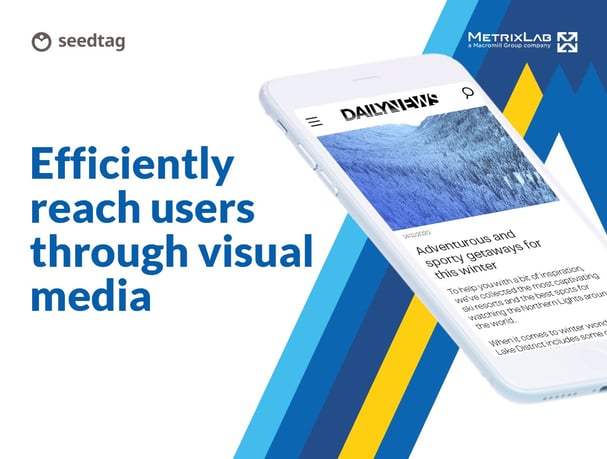Seedtag carried out a study performed by digital research agency MetrixLab that proves the effectiveness and prominence of visual elements to attract and maintain users’ attention.

The digital advertising industry is constantly evolving, and with recent changes and new regulations, advertisers are struggling to come up with new, effective and user-friendly ways to engage with users. For this reason, Seedtag wants to shed light on how the advertising industry can leverage the effectiveness and prominence of images and videos to catch users’ attention through research conducted by MetrixLab.
This study aims to prove up to what extent the usage of images as ad placement is able to capture users’ attention; to what extent users’ are more receptive and have more positive emotions when ads are aligned with their interests; and finally, how Seedtag’s solutions, combining contextual targeting and premium placements, translate into added value for brands in comparison to other display and video formats.
This research and its results are based on a robust study of over 1,000 consumers who evaluated both common display ads and In-Image advertising. All of the ad units were evaluated in-context on websites using a variety of system 1 and system 2 measurement techniques, including passive viewing tracking, emotional response, eye tracking and implicit response testing.
On one hand, the system 1 techniques were used to capture the emotions and implicit responses to advertising, revealing that creative and engaging formats are key to increase positive reactions to ads, and that Seedtag ads have more positive responses than regular ads, as they are found more attractive, enjoyable and interesting by users.
On the other hand, eye-tracking offered a simple, scientific and objective measure of the reality of users’ attention: instead of asking people questions, eye-tracking passively monitors what users actually looked at when navigating and the time they spent in each area of the page. This has shown that ads placed on visual elements are noticed 3.5 times (or 3.4 seconds) faster than other display and video ads. It also showed that for all formats, visuals within editorial content were the first element where users focused their attention, and finally, that ads placed on these visuals are able to maintain user’s attention 4x to 6.7 times longer.
One of the main takeaways of this research was the re-evaluation of viewability as a metric used to assess campaign performance, since elements such as ad creativity, ad placement and predisposition or affinity to content can influence the quality of the “view”. Thus, seedtag and MetrixLab went beyond viewability itself and developed a more comprehensive metric that is able to provide a more thorough measurement of a campaign. This new metric, called view quality, takes into consideration the percentage of people who were not just exposed to the ad but actually looked at it, and the length of time they spent watching it. The study revealed that seedtag’s contextually served ads have a view quality 5,5 times higher than other display/video ads.
Patricia Alfaro, seedtag's Sales Marketing Manager and responsible for research & insights at the company says that “given the new privacy regulations and the ad saturation within the digital ecosystem, we realized two challenges were giving our brands many headaches: users' scarce attention and the impossibility to reach them without 3rd party data.”
“We were confident in the ability of our ad solutions to give an answer to these challenges so we decided to team up with Metrixlab and conduct this in-depth study to obtain evidence. We utilized advanced methodologies to measure users' passive behaviour and the results confirmed that placing ads on images helped to drive attention and engagement quicker and for a longer time. Plus, delivering relevant ads aligned with the content users' were consuming translated into greater ad likeability and more positive perceptions”, adds Patricia.
Additionally, this study has also proven that the combination of unique placements and contextual delivery results in a better brand favourability, a stronger brand safety and a more positive mindset on users at the moment they are exposed to the ad. This also guarantees the ads are aligned with the content the viewer is consuming at the specific time of exposure, matching interests in real time and providing a better experience for consumers. The complete results of this study can be found here.
Thanks to its proprietary Cognitive Content Analysis (CCA) technology developed with the help of Machine Learning algorithms and its ability to integrate ads into images and now also into videos, Seedtag offers advertisers the possibility to develop their brand values by being associated with related content.



